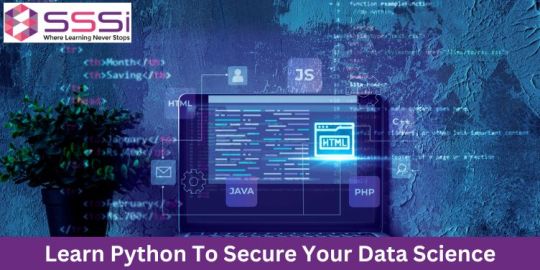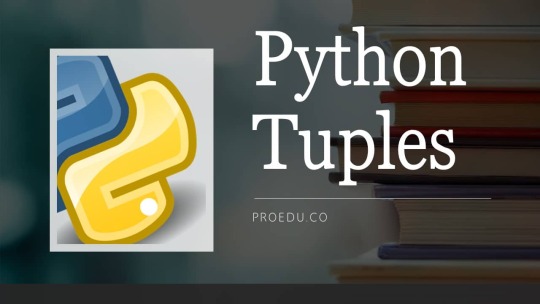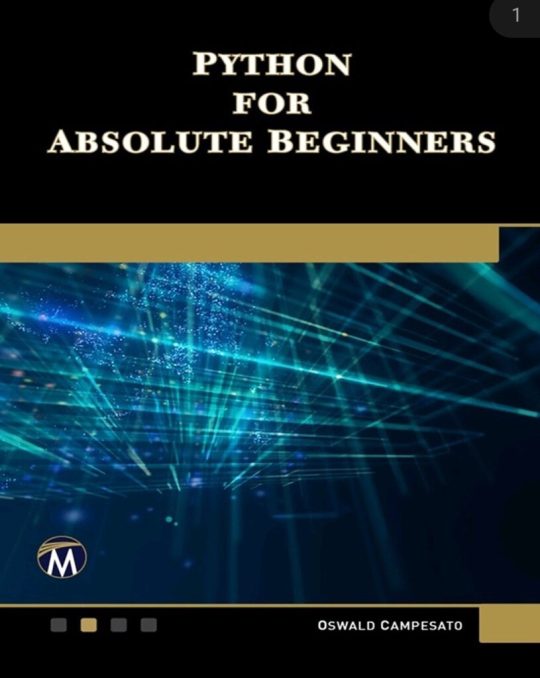#Python basics
Explore tagged Tumblr posts
Text

Learn Python To Secure Your Future In Data Science
Python is one of the most important coding or programming languages that is used by more than 8 million programmers as their main programming language.Now let's talk about how to learn Python. Python language is the basic and the easiest language compared to any other language.
To more info Visit us :- https://www.sssi.in/blog/engineering/learn-python-to-secure-your-future
#learn python#online training python#python developers#python basics#learn python for data analysis#python programming#coding python for beginners
2 notes
·
View notes
Text
Learn and enjoy!
youtube
Welcome to the "Interactive Free Python Lab" – your gateway to mastering Python programming! This free, comprehensive course is designed to take you from a complete beginner to an intermediate coder through interactive, hands-on learning. Our curriculum is organized into 21 structured sections covering everything from basic Python syntax to advanced topics like data science, machine learning, and artificial intelligence.
With over 400 practical examples accompanied by detailed explanations and exercises, you’ll learn to tackle real coding challenges and gain the confidence to create your own projects.
Embark on your coding journey today with Interactive Free Python Lab. Subscribe, learn, and join a vibrant community of aspiring developers and data enthusiasts who are transforming their futures through the power of Python. Your path to Python mastery starts here!
#python#coding#coder#python code#code#programming#python programming#coursera#data analytics#data science#education#online learning#python tutorial#learn python#python for beginners#data types#python basics#python learning#machine learning#artificial intelligence#free python course#Youtube
0 notes
Text

#Learn python#Python programming#Python bootcamp#Python online#Python coding#Python for beginners#Python tutor#Python developer#Learn python online#Python programming for beginners#Python for data science#Python machine learning#Python basics#Learn python programming#Python for everybody#Python language
0 notes
Text
beginning your career in python programming
0 notes
Text
What are Python modules and how do I use them?
Discover what Python modules are and how to use them to streamline your coding process. To learn Python basics, check out this resource: Python Basics. Explore more Python courses at FutureSkills Prime!
0 notes
Text
Getting Started with Python: Project 0 - “Hello, World”
Discover how to make your Python scripts more interactive and start your programming journey with confidence. Your support is much appreciated for me to get more content out for you! 😄👍🏽
Consider reviewing the basics with the following content: Getting Started with Python: Project 0 – “Hello, World” Getting Started with Python: A Beginner’s Guide pt3 Getting Started with Python: A Beginner’s Guide (pt 2) Getting Started with Python: A Beginner’s Guide (pt 1) Terminal Window – Command Line Interface This tutorial uses Visual Studio Code: To create and edit a Python file, use…

View On WordPress
#Beginner#Coding#Errors#Functions#Getting started with Python#Interactive Scripts#Learn Python#Learning Python#Programming#Python#Python basics#Python for beginners#Tutorial
0 notes
Text
Master Python Programming
Introduction to Python Programming
Python is a versatile programming language that has gained immense popularity in the field of data science and machine learning. Whether you are a beginner looking to learn the basics or an experienced programmer delving into advanced data analysis techniques, mastering Python is essential. In this comprehensive guide, we will walk you through the fundamental concepts and advanced topics in Python programming for data science.
Python programming has become a cornerstone in the world of technology. From web development to data analysis, machine learning, and automation, Python is a versatile language that opens a plethora of opportunities for anyone who masters it. Whether you are a college student looking to enhance your programming skills or an IT professional aiming to expand your knowledge base, learning Python can significantly benefit your career. In this blog post, we will delve into the essential aspects of mastering Python programming, providing you with a comprehensive guide to kickstart your journey into the world of Python.
Understanding Python Basics
Installing Python and Setting Up Development Environment
To start your Python journey, the first step is to install Python on your system and set up a development environment. You can download the latest version of Python from the official website and follow the installation instructions based on your operating system. Once installed, you can use popular Integrated Development Environments (IDEs) like PyCharm or Jupyter Notebook for coding.
Basic Syntax and Data Types
Python is known for its simple and clean syntax, making it easy to read and write code. It supports various data types such as integers, floats, strings, lists, tuples, dictionaries, etc. Understanding these basic data types is crucial for writing efficient Python code.
Control Structures and Loops
Control structures like if-else statements, loops (for and while), and functions help in controlling the flow of a Python program. Mastering these control structures is key to writing structured and organized code that executes efficiently.
Variables and Operators:
In Python, you can assign values to variables and perform operations using different operators like arithmetic, comparison, logical, and assignment operators. Mastering variables and operators is fundamental to writing efficient code in Python.
Dive Deeper into Python Programming
Once you have a solid understanding of the basics, you can delve deeper into various aspects of Python programming that will enhance your skills and knowledge. Let us explore some advanced topics in Python:
1. Functions:
Functions are essential for organizing code into reusable blocks. With Python, you can create functions using the def keyword and pass arguments to them. Understanding functions allows you to write modular and scalable code.
2. Libraries and Modules:
Python has a vast ecosystem of libraries and modules that provide ready-made solutions for various tasks. Libraries like NumPy, Pandas, Matplotlib, and TensorFlow are widely used in data analysis and machine learning. Learning how to import and use libraries will streamline your coding process.
3. Object-Oriented Programming (OOP):
Python supports object-oriented programming, allowing you to create classes and objects. This paradigm helps in organizing code in a more structured and efficient manner. Understanding OOP concepts like inheritance, polymorphism, and encapsulation will elevate your programming skills.
4. Error Handling:
Handling errors gracefully is crucial in Python programming. You can use try-except blocks to catch and manage exceptions, ensuring that your code runs smoothly even in the presence of unforeseen errors.
5. File Handling:
Python provides robust file handling capabilities, allowing you to read from and write to files. Understanding how to work with files in Python is essential for tasks like data processing and storage.
Working with Data in Python
Data manipulation is a core aspect of data science, and Python provides powerful tools for handling different types of data structures.
Data Structures in Python
Python offers built-in data structures like lists, tuples, and dictionaries that are widely used for storing and organizing data. Additionally, libraries like NumPy provide support for multidimensional arrays, while Pandas offers data frames for handling structured data.
Data Analysis and Visualization Techniques
Exploratory Data Analysis (EDA) is an essential step in any data science project, helping to understand the underlying patterns and relationships in the data.
Exploratory Data Analysis (EDA) with Python
Descriptive statistics and data visualization techniques play a crucial role in EDA. Python libraries like Matplotlib and Seaborn enable users to create insightful visualizations that aid in data interpretation and decision-making.
Advanced Python Programming for Data Science
Beyond the basic syntax and data structures, advanced Python programming concepts are essential for complex data analysis tasks.
Functions and Modules in Python
Writing custom functions and using pre-built Python modules are key skills for enhancing productivity and code reusability. Additionally, understanding exception handling and debugging techniques can help in troubleshooting errors effectively.
Machine Learning with Python
Python is the go-to language for machine learning projects, given its extensive libraries and tools for implementing various algorithms.
Introduction to Machine Learning
Supervised and unsupervised learning are common types of machine learning approaches that Python supports. The Scikit-Learn library offers a wide range of algorithms for building predictive models.
Practical Application of Python Programming
To truly master Python programming, you need to apply your knowledge to real-world projects. Here are some practical applications of Python that will help you sharpen your skills:
Web Development:
Python's frameworks like Django and Flask are popular choices for web development. Building web applications using Python will give you hands-on experience in creating dynamic and responsive websites.
Data Analysis:
Python's libraries like NumPy, Pandas, and Matplotlib are widely used in data analysis and visualization. Working on data analysis projects will familiarize you with handling datasets, performing statistical analysis, and creating insightful visualizations.
Machine Learning:
Python's library, TensorFlow, is a powerful tool for building machine learning models. Delving into machine learning projects will enable you to understand algorithms, train models, and make predictions based on data.
Automation:
Python can be used for automating repetitive tasks, such as file operations, data processing, or system maintenance. Developing automation scripts will enhance your efficiency and productivity in various workflows.
Conclusion
Mastering Python programming is not just about learning syntax and concepts; it is a journey of continuous exploration and growth. By understanding the basics, delving into advanced topics, applying your knowledge to practical projects, and embracing a mindset of lifelong learning, you can become proficient in Python programming and unlock a world of opportunities in the tech industry. So, roll up your sleeves, dive into Python, and let your coding journey begin!
Remember, the key to mastery lies in consistent practice, willingness to learn, and a passion for coding. Python is a versatile language that empowers you to create, innovate, and solve complex problems with ease. Embrace the power of Python, and watch your skills soar to new heights in the ever-evolving tech landscape. Happy coding!
1 note
·
View note
Text
Python Tuples
Tuples in Python are immutable sequences, similar to lists, but with the key distinction that once created, they cannot be modified. This immutability provides certain advantages, such as being used as keys in dictionaries or elements in sets, as well as ensuring data integrity in situations where the contents should not change. Here’s a basic overview of tuples in Python: 1.Creating…

View On WordPress
0 notes
Text
Python for Absolute Beginners
Python For Absolute Beginners ✅-1Download Python is a interpreted programming language.

View On WordPress
#dailyprompt#dailyprompt-2114#programming#python#python Basics#python Notes.pdf#python. python programming
0 notes
Text
Intro to Python Programming
Are you eager to kickstart your programming journey with a Python Basic Course? Look no further! Join our renowned institute in Delhi, offering the best Python Basic Course. Whether you're a beginner or need a refresher, our comprehensive curriculum covers all the fundamentals. From variables and data types to loops and functions, our expert instructors will guide you every step of the way. Don't miss this opportunity to acquire essential Python skills. Enroll now to unlock a world of programming possibilities.
#Best python training institute in delhi#Python basic course#python basics#learn python for beginners#python coding for beginners
0 notes
Text
What is the Purpose of Python training?
The purpose of Python training is to teach you the basics of the Python programming language. Python is a general-purpose programming language that is used for a variety of tasks, including: Web development Data science Machine learning Artificial intelligence Automation Python is a popular choice for beginners because it is easy to learn and use. It is also a powerful language that can be…
View On WordPress
#python#python programming#python tutorial#learn python#what is python#what is python used for#python tutorial for beginners#python for beginners#python course#python crash course#python basics#learn python programming#python full course#python language#python training#python programming language#what is python good for#python from scratch#python programming tutorial#python (programming language)#how to learn python#how fast is python
0 notes
Text
Does anyone wanna look at pictures of calculators with me
#or better yet does anyone have a calculator they wanna give me#i enjoy having them In my possession#they are my trinkets#autism special interest reveal:#calculators#everyone say the weird niche thing you collect below#Texas Instruments just announced new colors for the TI-84 Plus CE#which is kinda cool bc there haven’t been new colors since 2022 i think#but that’s still recent so idc lol#and they make all their calculators with PYTHON now ugh#which sounds neat but it drains the battery in like 2 minutes#and also whenever you wanna create a new program instead of taking you to the TI-Basic screen#you have the option to use Python but then you click that and it takes 3 years to load#i just wish they had an option to still get calculators WITHOUT Python#whatever i’m going to ebay
237 notes
·
View notes
Text
Built-in Functions for Strings in Python!
youtube
In this video, you'll discover the basic information you need to know about built-in functions for strings in Python! Whether you're a beginner or an intermediate coder, mastering these functions is essential for efficient text processing. We’ll cover key string functions, their applications, and how to use them to manipulate and analyze text data effectively. ✅ Subscribe to our channel so you don't miss more lessons on Python and programming!
#python#coding#coder#python code#code#programming#python programming#coursera#data analytics#data science#education#online learning#python tutorial#learn python#python for beginners#data types#python basics#python learning#machine learning#artificial intelligence#free python course#Youtube
0 notes
Text
#Learn python#Python programming#Python bootcamp#Python online#Python coding#Python for beginners#Python tutor#Python developer#Learn python online#Python programming for beginners#Python for data science#Python machine learning#Python basics#Learn python programming#Python for everybody#Python language
0 notes
Text
BEGINNING YOUR CAREER IN PYTHON : COMPREHENSIVE GUIDE
Starting your career in Python can be a rewarding endeavor; indeed, this is due to its versatility and demand in various fields. Therefore, here’s a comprehensive guide to help you navigate your journey from a beginner to a proficient Python developer.
1. Understanding Python Basics
What is Python basics?
A high-level, interpreted programming language, notably known for its readability and simplicity.
Installation
"First, download and install Python from the official website.
Then, set up an IDE (Integrated Development Environment) like PyCharm, VSCode, or Jupyter Notebook."
2. Deepening Your Knowledge
3. Exploring Libraries and Frameworks
4. Hands-On Practice
5. Version Control
1 note
·
View note
Note
Got any computer science pick up lines?
No but "item.status = "rejected" will get rid of programmers who may try to use them on you.
260 notes
·
View notes